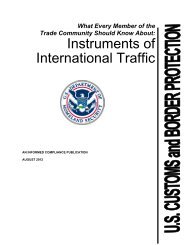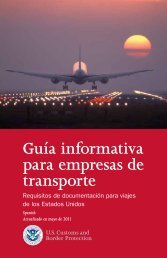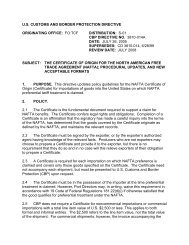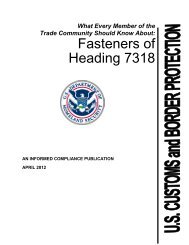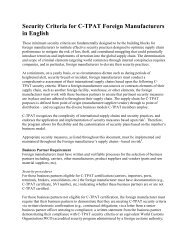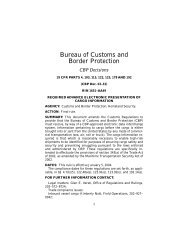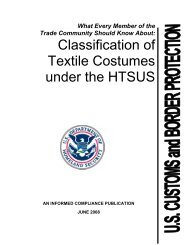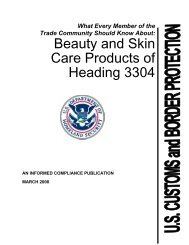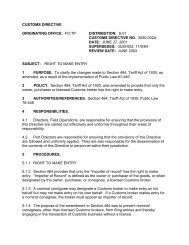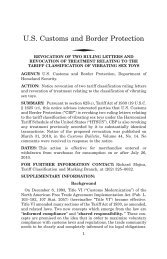Fiscal Year 2010 CBP Annual Financial Report - CBP.gov
Fiscal Year 2010 CBP Annual Financial Report - CBP.gov
Fiscal Year 2010 CBP Annual Financial Report - CBP.gov
Create successful ePaper yourself
Turn your PDF publications into a flip-book with our unique Google optimized e-Paper software.
Overview of <strong>CBP</strong><br />
• NTC-P targeting and support responsibilities have continued to grow with the ongoing expansion of the IAP;<br />
the Electronic System for Travel Authorization (ESTA); the expansion of the Stolen Lost Travel Document<br />
database (owned by the International Criminal Police Organization (ICPO) which is commonly known as<br />
INTERPOL Stolen Lost Travel Document database; and public health, outbound passenger targeting, and information<br />
sharing initiatives with Canada, Mexico and the United Kingdom.<br />
• In January <strong>2010</strong>, NTC-P implemented the Pre-Departure Program by utilizing ATS-P to identify high-risk<br />
passengers and other inadmissible aliens in an effort to prevent their departure prior to boarding commercial<br />
carriers bound to the United States from non-IAP locations. Through the end of FY <strong>2010</strong>, more than 1,100<br />
passengers were denied boarding on flights destined to the United States.<br />
• In an effort to strengthen air passenger security, NTC-P has modified its automated systems to conduct continuous<br />
vetting of visa revocations and denials. This continuous vetting will ensure that changes in visa<br />
status are propagated through the system in near real time allowing the NTC-P to immediately respond<br />
with a “No-Board” message that will be systematically transmitted directly to the airlines via the Advanced<br />
Passenger Information System (APIS) Quick Query.<br />
• During FY <strong>2010</strong>, NTC-P conducted training on the Air and Marine Operations Center (AMOC) at the March<br />
Air Reserve Base, Riverside, California to further develop joint targeting processes in the general aviation foreign<br />
arrival/departure environment.<br />
Additionally, NTC-P conducts liaison work with the Centers for Disease Control (CDC), Central Intelligence<br />
Agency (CIA), ICE, Federal Bureau of Investigation (FBI), Transportation Security Administration’s (TSA) Office of<br />
Intelligence, Federal Air Marshals, Department of State (DOS), USCG, and Citizenship and Immigration Services’<br />
Fraud Detection and National Security unit. <strong>CBP</strong> and TSA have established a joint Targeting Workgroup to leverage<br />
<strong>CBP</strong> capabilities with TSA authorities to ensure that high-risk passengers are screened overseas prior to boarding a<br />
conveyance bound for the United States.<br />
NTC-P has worked diligently to develop links within the Intelligence Community to apply knowledge and tools<br />
that enhance border security through data verification and other techniques to corroborate identity information<br />
and gain insight into commercial entities. NTC-P continues to streamline and facilitate the sharing of information<br />
to ensure the safety of the U.S. commercial passenger environment.<br />
These programs and areas of innovation establish NTC-P as <strong>CBP</strong>’s preeminent anti-terrorism facility. It is a prime<br />
example of pushing the zone of security outward and keeping terrorism at “arms length” by screening passengers<br />
before they arrive at the U.S. border.<br />
National Targeting Center – Cargo<br />
The National Targeting Center-Cargo (NTC-C) is a critical part in <strong>CBP</strong>’s layered enforcement strategy. NTC-C supports<br />
<strong>CBP</strong> cargo-related activities by proactively targeting and coordinating examinations of high-risk cargo in all<br />
modes of transportation; providing high-quality research to the Container Security Initiative (CSI), Secure Freight<br />
Initiative (SFI), domestic analytical units, and OGAs; and implementing new proactive methodologies. NTC-C<br />
Management’s Discussion and Analysis<br />
19






